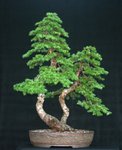Curious as to what "soil" mix you would use. I've been growing mtn hemlock in pots for a decade or so, (mostly for work, only last ~2 years for bonsai I admit). I usually use 50/50 organic / draining mix and they seem to like it here and grow well.
Mountain Hemlock are collected on sites that are basically composed of decomposed granite. The ones with the best feeder roots and the healthiest grow in rock pockets. They also inhabit edge of bog sites, but the root formation in those sites is very poor with few feeder roots! Collectors have in the past put newly collected hemlock on the ground and covered with sea soil and pumice mix. This works with free drainage through the ground but tends to stay too wet in rainy season with fungal issues prevalent and lower percentage of survival!
I use pure pumice around the collected soil and change out the native soil slowly in segmented fashion to retain as many feeder roots as possible throughout the process. ( A method taught to me by Michael Hagedorn . Michael is one of the top professionals in the PNW who are very familiar with Mountain Hemlock. I consider his styling of Hemlock to be the best! )
Once the native soil is changed out I keep all Hemlock in the following combination. Akadama , Pumice , Granite , Lava.
I would vary the percentage of Akadama and Pumice based on the climate. Wetter climate, lower percentages of akadama and pumice for a drier mix!
You may also wish to increase % if you wish to water less often. Then the trees must be protected in the rainy season or problems will occur.
For a general guideline consider the following:
Akadama 15 to 25% ( similar particle size, structure, higher moisture retention and CEC capacity)
Pumice 20 to 30 % ( similar particle size, structure, good moisture retention)
Lava 20 to 30% ( similar particle size, structure, some moisture retention)
Granite 15 to 20 % ( primarily to add weight and mineral elements)
I use organic fertilizer that I make myself! However many products can be used successfully if understood and applied correctly! I always recommend lower number regardless of the form. Prefer all three numbers below 10.
Just my approach, no worries if you feel comfortable going in a different direction.




